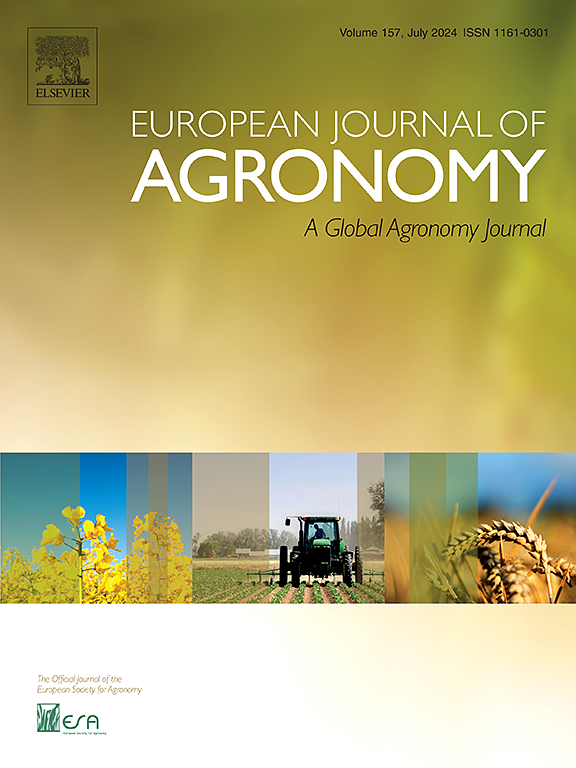氮营养指数作为评估马铃薯基因型氮利用效率的工具
IF 4.5
1区 农林科学
Q1 AGRONOMY
引用次数: 0
摘要
提高氮(N)的利用效率(NUE)对马铃薯(Solanum tuberosum L.)的可持续生产至关重要。本研究的目的是评估 i)氮利用效率主要成分(氮利用率(NUTE)和氮回收率(NRE))的基因型差异;ii)这些成分、相关性状和栽培品种之间的关联;iii)氮营养指数(NNI)在评估不同氮供应水平下马铃薯基因型的氮利用率和氮回收率方面的实用性。2021-2022 年期间在智利进行了两项田间试验。处理是 15 个马铃薯栽培品种和三种氮肥(0、200 和 400 千克/公顷)的组合。在总干物质生物量(DM)(5.9-22.1 毫克/公顷-1)、块茎 DM 生物量(5.1-18.3 毫克/公顷-1)、总氮浓度(1.01-2.24 %)、总氮吸收量(98-323 千克/公顷-1)、NUTE(35-91 千克块茎 DM 千克-1 N)和 NRE(-14-54 %)方面观察到了很大的差异。总吸氮量与总 DM 生物量以及与氮浓度和吸氮量相关的性状有显著关系。在这两项实验中,都观察到总氮浓度与 NUTE 之间存在较强的负相关(r = -0.95 - -0.98)。此外,NUTE 和氮收获指数呈正相关。负幂函数很好地描述了 NUTEtub 和 NNI 之间的关系(p < 0.01; R2 = 0.55-0.87)。NNI = 1(最佳氮状态)时的 NUTEtub 预测平均值范围很窄(49.5-56.9 千克 DM kg-1 N)。相对块茎产量和相对总生物量都与氮营养状况指数显著相关(R2 = 0.56 和 0.66)。栽培品种 Desiree、Karu-INIA 和 Shepody 是 NNI 最高的栽培品种。NRE 与 NNI 之间存在明显的正相关关系(p < 0.01; R2 = 0.42)。这项研究证明了 NNI 在根据基因型和氮素供应量评估和解释 NUTE 和 NRE 方面的有效性,最终加强了对改善马铃薯生产系统氮利用效率的决策支持。本文章由计算机程序翻译,如有差异,请以英文原文为准。
The nitrogen nutrition index as a tool to assess nitrogen use efficiency in potato genotypes
Enhancing nitrogen (N) use efficiency (NUE) is crucial for the sustainable production of potatoes (Solanum tuberosum L.). The aims of this study were to assess i) the genotypic variation of the main components of NUE (N utilization efficiency (NUTE) and N recovery efficiency (NRE)), ii) the association between these components, related traits, and cultivars, and iii) the usefulness of N nutrition index (NNI) to assess NUTE and NRE of potato genotypes grown under different levels of N availability. Two field experiments were carried out in Chile during the season 2021–2022. Treatments were the combination of 15 potato cultivars and three rates of N (0, 200, and 400 kg N ha−1). High variations were observed in total dry matter biomass (DM) (5.9–22.1 Mg ha−1), tuber DM biomass (5.1–18.3 Mg ha−1), total N concentration (1.01–2.24 %), total N uptake (98–323 kg ha−1), NUTE (35–91 kg tuber DM kg−1 N), and NRE (−14–54 %). Total N uptake was significantly related to total DM biomass and traits related to N concentration and N uptake. In both experiments, strong negative correlations were observed between total N concentration and NUTE (r = −0.95 – −0.98). Also, NUTE and N harvest index were positively correlated. The relationship between NUTEtub and NNI was well described (p < 0.01; R2 = 0.55–0.87) by a negative power function. The predicted average of NUTEtub for a NNI = 1 (optimal N status) showed a narrow range (49.5–56.9 kg DM kg−1 N). Both relative tuber yield and relative total biomass were significantly related to NNI (R2 = 0.56 and 0.66). The cultivar Desiree, Karu-INIA, and Shepody were among the cultivars with the highest NNI. A significant positive relationship (p < 0.01; R2 = 0.42) was observed between NRE and NNI. This study demonstrates the effectiveness of the NNI in evaluating and interpreting NUTE and NRE based on genotype and nitrogen supply, ultimately enhancing decision support for improving NUE in potato production systems.
求助全文
通过发布文献求助,成功后即可免费获取论文全文。
去求助
来源期刊

European Journal of Agronomy
农林科学-农艺学
CiteScore
8.30
自引率
7.70%
发文量
187
审稿时长
4.5 months
期刊介绍:
The European Journal of Agronomy, the official journal of the European Society for Agronomy, publishes original research papers reporting experimental and theoretical contributions to field-based agronomy and crop science. The journal will consider research at the field level for agricultural, horticultural and tree crops, that uses comprehensive and explanatory approaches. The EJA covers the following topics:
crop physiology
crop production and management including irrigation, fertilization and soil management
agroclimatology and modelling
plant-soil relationships
crop quality and post-harvest physiology
farming and cropping systems
agroecosystems and the environment
crop-weed interactions and management
organic farming
horticultural crops
papers from the European Society for Agronomy bi-annual meetings
In determining the suitability of submitted articles for publication, particular scrutiny is placed on the degree of novelty and significance of the research and the extent to which it adds to existing knowledge in agronomy.
 求助内容:
求助内容: 应助结果提醒方式:
应助结果提醒方式:


